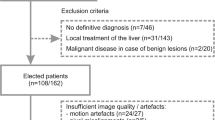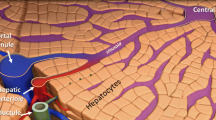Abstract
Multidetector CT (MDCT) provides new opportunities for hepatic tumor characterization. By coupling high-resolution isotropic datasets with advanced post-processing tools, maps of tumor vascularity can be generated to elucidate characteristic findings. This two-part review describes a range of benign and malignant liver masses, with emphasis on IV contrast-enhanced MDCT features and vascular signatures that can be identified on 3D vascular mapping.







Similar content being viewed by others
References
Foley WD, Mallisee TA, Hohenwalter MD, et al. (2000) Multiphase hepatic CT with a multirow detector CT scanner. AJR Am J Roentgenol 175:679–685
Francis IR, Cohan RH, McNulty NJ, et al. (2003) Multidetector CT of the liver and hepatic neoplasms: effect of multiphasic imaging on tumor conspicuity and vascular enhancement. AJR Am J Roentgenol 180:1217–1224
Johnson PT, Fishman EK (2006) IV contrast selection for MDCT: current thoughts and practice. AJR Am J Roentgenol 186:406–415
Yanaga Y, Awai K, Nakaura T, et al. (2008) Optimal contrast dose for depiction of hypervascular hepatocellular carcinoma at dynamic CT using 64-MDCT. AJR Am J Roentgenol 190:1003–1009
Bae KT (2010) Intravenous contrast medium administration and scan timing at CT: considerations and approaches. Radiology 256:32–61
Heiken JP, Brink JA, McClennan BL, et al. (1995) Dynamic incremental CT: effect of volume and concentration of contrast material and patient weight on hepatic enhancement. Radiology 195:353–357
Cowles RA, Mulholland MW (2000) Solitary hepatic cysts. J Am Coll Surg 191:311–321
Carrim ZI, Murchison JT (2003) The prevalence of simple renal and hepatic cysts detected by spiral computed tomography. Clin Radiol 58:626–629
Torres VE, Harris PC, Pirson Y (2007) Autosomal dominant polycystic kidney disease. Lancet 369:1287–1301
Inaba T, Nagashima I, Ogawa F, et al. (2003) Diffuse intrahepatic bile duct dilation caused by a very small hepatic cyst. J Hepatobiliary Pancreat Surg 10:106–108
Mortele KJ, Segatto E, Ros PR (2004) The infected liver: radiologic–pathologic correlation. Radiographics 24:937–955
Halvorsen RA, Korobkin M, Foster WL, et al. (1984) The variable CT appearance of hepatic abscesses. AJR Am J Roentgenol 142:941–946
Zonios D, Soula M, Archimandritis AJ, et al. (2003) Cystlike hepatic metastases from gastrointestinal stromal tumors could be seen before any treatment. AJR Am J Roentgenol 181:282 (author reply 282)
Freeny PC (1983) Angiography of hepatic neoplasms. Semin Roentgenol 18:114–122
Karhunen PJ (1986) Benign hepatic tumours and tumour like conditions in men. J Clin Pathol 39:183–188
Gandolfi L, Leo P, Solmi L, et al. (1991) Natural history of hepatic haemangiomas: clinical and ultrasound study. Gut 32:677–680
Farges O, Daradkeh S, Bismuth H (1995) Cavernous hemangiomas of the liver: are there any indications for resection? World J Surg 19:19–24
Saegusa T, Ito K, Oba N, et al. (1995) Enlargement of multiple cavernous hemangioma of the liver in association with pregnancy. Intern Med 34:207–211
Biecker E, Fischer HP, Strunk H, et al. (2003) Benign hepatic tumours. Z Gastroenterol 41:191–200
Kamel IR, Liapi E, Fishman EK (2005) Liver and biliary system: evaluation by multidetector CT. Radiol Clin North Am 43:977–997, vii
Oto A, Tamm EP, Szklaruk J (2005) Multidetector row CT of the liver. Radiol Clin North Am 43:827–848, vii
Belli L, De Carlis L, Beati C, et al. (1992) Surgical treatment of symptomatic giant hemangiomas of the liver. Surg Gynecol Obstet 174:474–478
Ungermann L, Elias P, Zizka J, et al. (2007) Focal nodular hyperplasia: spoke-wheel arterial pattern and other signs on dynamic contrast-enhanced ultrasonography. Eur J Radiol 63:290–294
Buetow PC, Pantongrag-Brown L, Buck JL, et al. (1996) Focal nodular hyperplasia of the liver: radiologic–pathologic correlation. Radiographics 16:369–388
Wanless IR, Mawdsley C, Adams R (1985) On the pathogenesis of focal nodular hyperplasia of the liver. Hepatology 5:1194–1200
Leconte I, Van Beers BE, Lacrosse M, et al. (2000) Focal nodular hyperplasia: natural course observed with CT and MRI. J Comput Assist Tomogr 24:61–66
Nguyen BN, Flejou JF, Terris B, et al. (1999) Focal nodular hyperplasia of the liver: a comprehensive pathologic study of 305 lesions and recognition of new histologic forms. Am J Surg Pathol 23:1441–1454
Cherqui D, Rahmouni A, Charlotte F, et al. (1995) Management of focal nodular hyperplasia and hepatocellular adenoma in young women: a series of 41 patients with clinical, radiological, and pathological correlations. Hepatology 22:1674–1681
Brancatelli G, Federle MP, Grazioli L, et al. (2001) Focal nodular hyperplasia: CT findings with emphasis on multiphasic helical CT in 78 patients. Radiology 219:61–68
Johnson PT, Zaheer A, Anders R, et al. (2010) Dual-phase computed tomographic angiography of focal nodular hyperplasia: defining predictable postcontrast attenuation levels relative to aorta and inferior vena cava. J Comput Assist Tomogr 34:720–724
Welch TJ, Sheedy PF 2nd, Johnson CM, et al. (1985) Focal nodular hyperplasia and hepatic adenoma: comparison of angiography, CT, US, and scintigraphy. Radiology 156:593–595
Yang CY, Ho MC, Jeng YM, et al. (2007) Management of hepatic angiomyolipoma. J Gastrointest Surg 11:452–457
Nonomura A, Mizukami Y, Kadoya M (1994) Angiomyolipoma of the liver: a collective review. J Gastroenterol 29:95–105
Buell JF, Tranchart H, Cannon R, et al. (2010) Management of benign hepatic tumors. Surg Clin North Am 90:719–735
Dalle I, Sciot R, de Vos R, et al. (2000) Malignant angiomyolipoma of the liver: a hitherto unreported variant. Histopathology 36:443–450
Croquet V, Pilette C, Aube C, et al. (2000) Late recurrence of a hepatic angiomyolipoma. Eur J Gastroenterol Hepatol 12:579–582
Mortele KJ, Ros PR (2002) Benign liver neoplasms. Clin Liver Dis 6:119–145
Mergo PJ, Ros PR (1998) Benign lesions of the liver. Radiol Clin North Am 36:319–331
Soe KL, Soe M, Gluud C (1992) Liver pathology associated with the use of anabolic–androgenic steroids. Liver 12:73–79
Reddy KR, Kligerman S, Levi J, et al. (2001) Benign and solid tumors of the liver: relationship to sex, age, size of tumors, and outcome. Am Surg 67:173–178
Rabe T, Feldmann K, Grunwald K, et al. (1994) Liver tumours in women on oral contraceptives. Lancet 344:1568–1569
Meissner K (1998) Hemorrhage caused by ruptured liver cell adenoma following long-term oral contraceptives: a case report. Hepatogastroenterology 45:224–225
Dokmak S, Paradis V, Vilgrain V, et al. (2009) A single-center surgical experience of 122 patients with single and multiple hepatocellular adenomas. Gastroenterology 137:1698–1705
Guttmacher AE, Marchuk DA, White RI Jr (1995) Hereditary hemorrhagic telangiectasia. N Engl J Med 333:918–924
Ianora AA, Memeo M, Sabba C, et al. (2004) Hereditary hemorrhagic telangiectasia: multi-detector row helical CT assessment of hepatic involvement. Radiology 230:250–259
Garcia-Tsao G, Korzenik JR, Young L, et al. (2000) Liver disease in patients with hereditary hemorrhagic telangiectasia. N Engl J Med 343:931–936
Buscarini E, Buscarini L, Danesino C, et al. (1997) Hepatic vascular malformations in hereditary hemorrhagic telangiectasia: Doppler sonographic screening in a large family. J Hepatol 26:111–118
Memeo M, Stabile Ianora AA, Scardapane A, et al. (2004) Hepatic involvement in hereditary hemorrhagic telangiectasia: CT findings. Abdom Imaging 29:211–220
Buscarini E, Buscarini L, Civardi G, et al. (1994) Hepatic vascular malformations in hereditary hemorrhagic telangiectasia: imaging findings. AJR Am J Roentgenol 163:1105–1110
Hashimoto M, Tate E, Nishii T, et al. (2003) Angiography of hepatic vascular malformations associated with hereditary hemorrhagic telangiectasia. Cardiovasc Intervent Radiol 26:177–180
Author information
Authors and Affiliations
Corresponding author
Rights and permissions
About this article
Cite this article
Ahmed, S., Johnson, P.T. & Fishman, E.K. Defining vascular signatures of benign hepatic masses: role of MDCT with 3D rendering. Abdom Imaging 38, 755–762 (2013). https://doi.org/10.1007/s00261-012-9956-5
Published:
Issue Date:
DOI: https://doi.org/10.1007/s00261-012-9956-5




